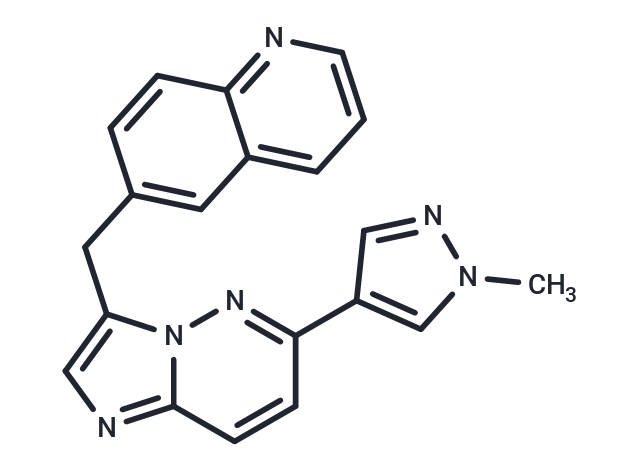Shopping Cart
- Remove All
 Your shopping cart is currently empty
Your shopping cart is currently empty

NVP-BVU972 is a selective and potent Met inhibitor with IC50 of 14 nM.

| Pack Size | Price | Availability | Quantity |
|---|---|---|---|
| 1 mg | $40 | In Stock | |
| 5 mg | $113 | In Stock | |
| 10 mg | $163 | In Stock | |
| 25 mg | $313 | In Stock | |
| 50 mg | $446 | In Stock | |
| 100 mg | $629 | In Stock | |
| 1 mL x 10 mM (in DMSO) | $126 | In Stock |
| Description | NVP-BVU972 is a selective and potent Met inhibitor with IC50 of 14 nM. |
| Targets&IC50 | MET:14 nM |
| In vivo | NVP-BVU972 effectively inhibited the growth of MET gene-dispersed cell lines GTL-16, MKN-45, and EBC-1 with IC50 of 66, 82, and 32 nM, respectively.NVP-BVU972 effectively inhibited the MET kinase, while the inhibition of other kinases (including the most closely related ones), RON, was very low, with an IC50 of >1000 nM.NVP-BVU972 inhibited GTL-16, MKN-45 and EBC-1 with IC50 of >1000 nM.NVP-BVU972 inhibited GTL-16, MKN-45 and EBC-1 with IC50 of >1000 nM. BVU972 inhibited constitutive MET phosphorylation in GTL-16 cells and HGF-stimulated MET phosphorylation in A549 cells with IC50s of 7.3 and 22 nM, respectively.NVP-BVU972 acted on BaF3 cells expressing wild-type TPR-MET and dose-dependently decreased TPR-MET phosphorylation. |
| Kinase Assay | TR-FRET biochemical assay with MET wild type and mutants: Enzyme activity is measured in a time resolved fluorescence resonance energy transfer (TR-FRET) assay, detecting tyrosine phosphorylation with a Eu-labelled anti-phospho-tyrosine antibody (fluorescence donor) and Allophycocyanin conjugated to Streptavidin (fluorescence acceptor) which binds to a biotin on the substrate peptide. For each variant, Km concentrations for ATP are determined in the absence of NVP-BVU972, and the ATP concentration in the kinase reaction is set to Km (4 μM for MET wt, 1 μM for MET Y1230H and MET F1200I). NVP-BVU972 is dissolved and diluted in DMSO and assayed in quadruplicate. Kinase reactions are carried out in 50 mM Tris-HCl pH 7.5, 8 mM MgCl2, 4 mM MnCl2, 0.05 % Tween 20, 0.05% bovine serum albumin, 0.1 mM EDTA, 1 mM DTT, 0.1 mM Na3VO4, in white 1536 well plates at room temperature. NVP-BVU972 and enzyme are incubated in a volume of 2 μL for 20 min, followed by the addition of 1 μL ATP and 1 μL biotinylated peptide substrate (PTK1) to final concentrations of Km and 1 μM, respectively. Enzyme concentrations in the reactions are 5 nM for MET wt, and 4 nM for the F1200I and Y1230H variants. After 90 min, reactions are stopped by addition of 1 μL stop/detection solution to reach final concentrations of 10 mM EDTA, 3.5 nM Eu-labelled antiphospho-tyrosine antibody PY20, and 10 nM Streptavidin Allophycocyanin. Time resolved fluorescence resonance energy transfer is measured in an Envision plate reader (excitation 320 nm, emission 615 nm and 665 nm). |
| Cell Research | BaF3 cells containing TPR-MET or various mutants thereof are grown in RPMI 1640 medium containing 10% fetal calf serum. For maintenance of parental BaF3 cells the medium is additionally supplemented with 10 ng/mL interleukin-3 (IL-3). For proliferation assays, BaF3 cells are seeded on 96-well-plates in triplicates at 104 cells per well and incubated with various concentrations of NVP-BVU972 for 72 hours followed by quantification of viable cells using a resazurin sodium salt dye reduction readout. IC50 values are determined with the XLFit Excel Add-In using a 4-parameter dose response model.(Only for Reference) |
| Molecular Weight | 340.38 |
| Formula | C20H16N6 |
| Cas No. | 1185763-69-2 |
| Smiles | Cn1cc(cn1)-c1ccc2ncc(Cc3ccc4ncccc4c3)n2n1 |
| Relative Density. | 1.35 g/cm3 |
| Storage | Powder: -20°C for 3 years | In solvent: -80°C for 1 year | Shipping with blue ice. | |||||||||||||||||||||||||||||||||||
| Solubility Information | DMSO: 45 mg/mL (132.21 mM), Sonication is recommended. Ethanol: 63 mg/mL (185.09 mM), Sonication is recommended. H2O: < 1 mg/mL (insoluble or slightly soluble) | |||||||||||||||||||||||||||||||||||
Solution Preparation Table | ||||||||||||||||||||||||||||||||||||
DMSO/Ethanol
| ||||||||||||||||||||||||||||||||||||

Copyright © 2015-2025 TargetMol Chemicals Inc. All Rights Reserved.